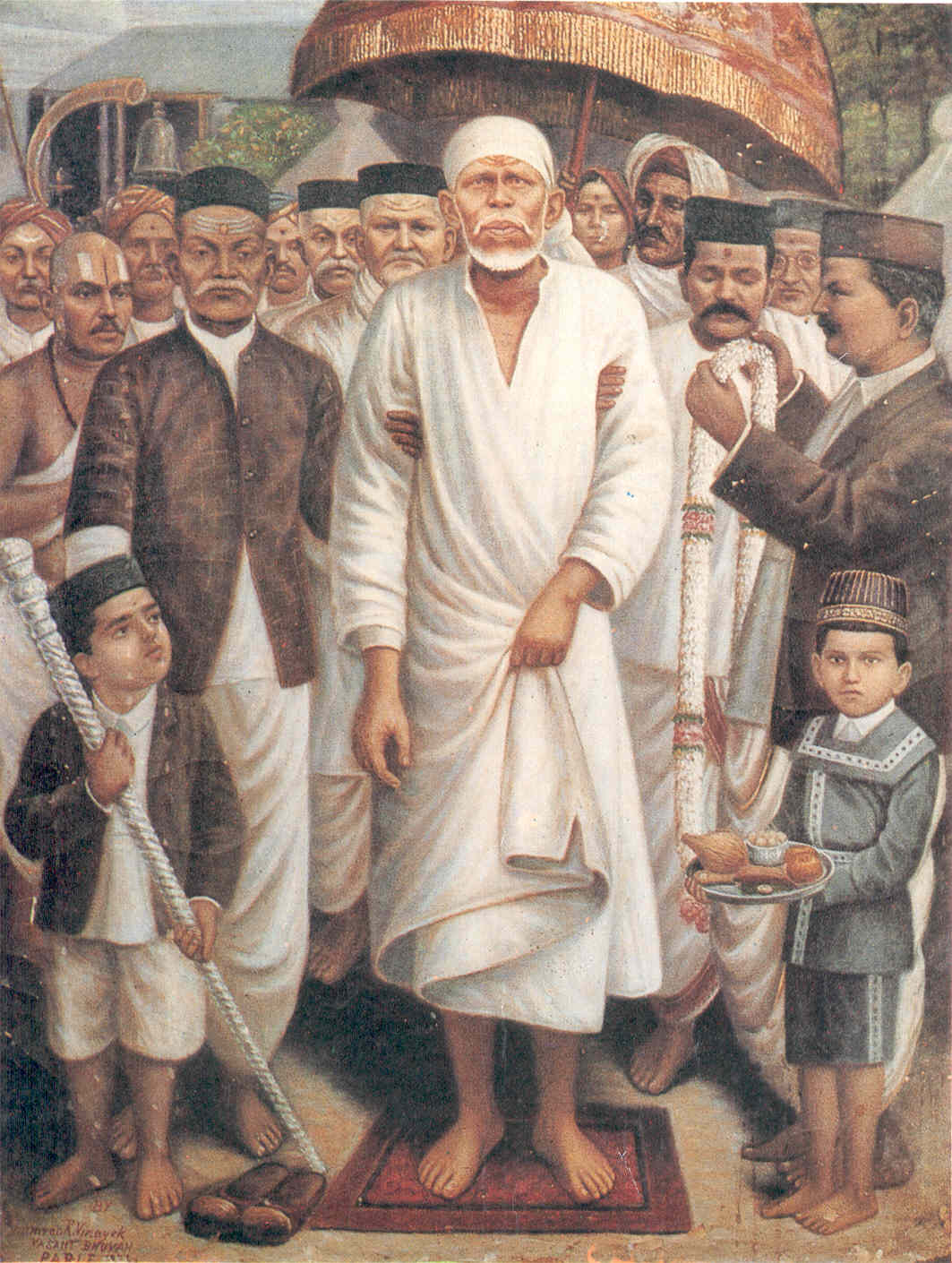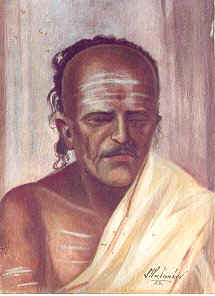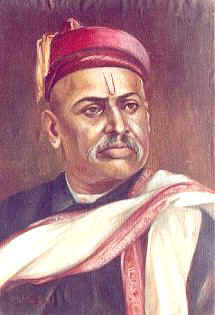 SABURI
SABURI
 SABURI
SABURI
Sai Bhajana Bina Sukha Shaanti Nahi Hari Naam Bina Aanand Nahi Prema Bhakthi Bina Uddhaar Nahi Guru Seva Bina Nirvaan Nahi ...Sai Bhajana Japa Dhyaana Bina Samyog Nahi Prabhu Darsa Bina Prajnan Nahi Daya Dharma Bina Sat Karma Nahi Bhagawaan Bina Koyi Apna Nahi Sai Ram Bina Paramaatma Nahi (Without singing Sai Bhajan, it is not possible to find peace and happiness. Without worshipping Shree Krishna it is not possible to gain bliss. Without love, devotion and detachment liberation is not possible. Without service to the divine teacher salvation is not possible. Without meditation and repetition of God's name Samadhi or union with god is not possible. Without a desire to realize god, supreme knowledge cannot be attained. Without kindness and right conduct no act can be called a good act. There is no one that we can call our own except god. There is no Lord except the Supreme Lord Of Lords, Sai Nath.)

|
SHRI SAI SATHCHARITHASada nimbavrukshasya muladhiwasa tsuda stra vinam tiktampya priyatam Tarukalpa vrukshadhikam sadhayantam namameeshwaram sadgurum sainaadham |

|
| Mhalsapati |
Chapter V |
Nanasahebchandorkar |
Baba's Return with Chand Patil's Marriage - party - Welcomed and Addressed as "Sai" - Contact with Other Saints - His Dress and Daily Routine - The Story of the Padukas - Wrestling Bout with Mohdin and Change in Life - Turning Water into Oil - The Pseudo - Guru Javhar Ali.
Return with Chand Patil's Marriage - Party
A
s hinted in the last Chapter, I shall now describe first how Sai Baba returned to Shirdi after His disappearance.There lived in the Aurangabad District (Nizam State), in a village called Dhoop, a well-to-do Mahomedan gentleman by name Chand Patil. While he was making a trip to Aurangabad, he lost his mare. For two long months, he made a diligent search but could get no trace of the lost mare. After being disappointed, he returned from Aurangabad with the saddle on his back. After travelling four Koss and a half, he came, on the way, to a mango tree under the foot of which sat a RATNA (queer fellow). He had a cap on His head, wore Kafni (long robe) and had a "Satka" (short stick) under His arm-pit and He was preparing to smoke a Chilim (pipe). On seeing Chand Patil pass by the way, He called out to him and asked him to have a smoke and to rest a little. The Fakir asked him about the saddle. Chand Patil replied that it was of his mare which was lost. The queer fellow or Fakir asked him to make a search in the Nala close by. He went and the wonder of wonders! he found out the mare. He thought that this Fakir was not an ordinary man, but an Avalia (a great saint). He returned to the Fakir with the mare. The Chilim was ready for being smoked, but two things were wanting; (1) fire to light the pipe, and (2) water to wet the chhapi (piece of cloth through which smoke is drawn up). The Fakir took His prong and thrust it forcibly into the ground and out came a live burning coal, which He put on the pipe. Then He dashed the Satka on the ground, from whence water began to ooze. The chhapi was wetted with that water, was then wrung out and wrapped round the pipe. Thus everything being complete, the Fakir smoked the Chilim and then gave it also to Chand Patil. On seeing all this, Chand Patil was wonderstruck. He requested the Fakir to come to his home and accept his hospitality. Next day He went to the Patil's house and stayed there for some time. The Patil was a village - officer of Dhoop. His wife's brother's son was to be married and the bride was from Shirdi. So Patil made preparations to start for Shirdi for the marriage. The Fakir also accompanied the marriage-party. The marriage went off without any hitch, the party returned to Dhoop, except the Fakir alone stayed in Shirdi, and remained there forever.
How the Fakir Got the Name Sai
When the marriage - party came to Shirdi, it alighted at the foot of a Banyan tree in Bhagata Mhalsapati's field near Khandoba's temple. The carts were loosened in the open court-yard of Khandoba's temple. The carts were loosened in the open court-yard of Khandoba's temple, and the members of the party descended one by one, and the Fakir also got down. Bhagat Mhalsapati saw the young Fakir getting down and accosted Him "YA SAI" (Welcome Sai). Others also addressed Him as Sai and thence-forth he became known as Sai Baba.
Contact with Other Saints
S
ai Baba began to stay in a deserted Masjid. One Saint named Devidas was living in Shirdi many years before Baba came there. Baba liked his company. He stayed with him in the Maruti temple, in the Chavadi, and some time lived alone. Then came another Saint by name Jankidas. Baba spent most of His time in talking with him, or Jankidas went to Baba's residence . So also one Vaishya house-holder Saint, from Puntambe by name Gangagir always frequented Shirdi. When he first saw Sai Baba, carrying pitchers of water in both hands, for watering the garden, he was amazed and said openly, "Blessed is Shirdi, that it got this precious Jewel. This man is carrying water to-day; but He is not an ordinary fellow. As this land (Shirdi) was lucky and meritorious, it secured this Jewel." So also one famous Saint by name Anandnath of Yewala Math, a disciple of Akkalkot Maharaj came to Shirdi with some Shirdi people. When he saw Sai Baba, he said openly, "This is a precious Diamond in reality. Though he looks like an ordinary man, he is not a 'gar' (ordinary stone) but a Diamond. You will realize this in the near future." Saying this he returned to Yewala. This was said while Sai Baba was a youngster.Baba's Dress and Daily Routine
I
n his young days, Sai Baba grew hair on His head; never had His head shaved. He dressed like an athlete. When He went to Rahata (3 miles from Shirdi), He brought with Him small plants of Merry Gold, Jai and Jui, and after cleaning, he planted and watered them. A devotee by name Vaman Tatya supplied Him daily with two earthen pitchers. With these Baba Himself used to water the plants. He drew water from the well and carried the pitchers on His shoulders. In the evening the pitchers were kept at the foot of the Neem tree. As soon as they were placed there, they were broken, as they were made of raw earth and not baked. Next day, Tatya supplied two fresh pitchers. This course went on for 3 years; and with Sai Baba's toil and labour, there grew a flower-garden. On this site, at present, stands the big mansion - Samadhi Mandir of Baba, which is now frequented and used by so many devotees.The Story of Padukas (foot-prints) under the Neem Tree
A devotee of Akkalkot Maharaj by name Bhai Krishnaji Alibagkar worshipped the photo of Akkalkot Maharaj. He once thought of going to Akkalkot (Sholapur District), taking the darshana of the Padukas (foot-prints) of the Maharaj and offering his sincere worship there; but before he could go there, he got a vision in his dream. Akkalkot Maharaj appeared in the vision and said to him - "Now Shirdi is my resting place, go there and offer your Worship." So Bhai changed his plan and came to Shirdi, worshipped Baba, stayed there for six months and was happy. As a reminiscence of this vision etc., he prepared the Padukas and installed them on an auspicious day of Shravan, Shaka 1834 (1912 A.D.) under the Neem tree with due ceremonies and formalities, conducted by Dada Kelkar and Upasani. One Dixit Brahmin was appointed for worship, and the management was entrusted to devotee Sagun.
Complete Version of this Story
Mr. B.V. Deo, Retired Mamalatdar of Thana, and a great devotee of Sai Baba, made enquired about this matter with Sagun Meru Naik and Govind Kamlakar Dixit and has published a full version of the Padukas in Sai Leela Vol. 11, No. 1, page 25. It runs as follows:
In 1834 Shaka (1912 A.D.) one Doctor Ramarao Kothare of Bombay came to Shirdi for Baba's darshana. His compounder; and his friend, Bhai Krishnaji Alibagkar, accompanied him. The compounder and Bhai became intimate with Sagun Meru Naik and G.K. Dixit. While discussing things, these persons thought that there must be some memorial of the fact of Sai Baba's first coming to Shirdi and sitting under the holy Neem tree. They thought of installing Baba's Padukas there and were going to make them of some rough stones. Then Bhai's friend, the compounder, suggested that if this matter be made known to his master, Dr. Ramarao Kothare, who would prepare nice Padukas for this purpose. All liked the proposal and Dr. Kothare was informed of it. He came to Shirdi and drew a plan of the Padukas. He went to Upasani Maharaj in Khandoba's temple, and showed him his plan. The latter made many improvements, drew lotuses, flowers, conch, disc, man etc., and suggested that the following SHLOKA (verse) regarding Neem tree's great ness and Baba's Yogi powers be inscribed. The verse was as follows:
"Sada Nimbarvrikshasya mooladhiwasat,
Sudhasravinam tiktamapi-apriyam tam,
Tarum Kalpavrikshadhikam sadhayantam
Namameeshwaram Sadgurum Sai Natham"
Upasani's suggestions were accepted and carried out. The Padukas were made in Bombay and sent to Shirdi with the compounder. Baba said that they should be installed on the Pournima (15th) of Shravan. On that day at 11 a.m., G.K. Dixit brought them on his head from Khandoba's temple to the Dwarkamai (Masjid) in procession. Baba touched the Padukas, saying that these are the feet of the Lord and asked the people to instal them, under foot of the Neem tree.
A day before, one Parsi devotee of Bombay named Pastha Shet sent Rs.25/- by money order. Baba gave this sum for the installation of the Padhukas. The total expense of installation came up to Rs.100/- out of which Rs.75/- were collected by subscriptions. For the first 5 years, G.K. Dixit worshipped the Padukas daily and then this was done by Laxman Kacheshwar Jakhadi. In the first five years, Dr. Kothare sent Rs. 2 per month for lighting and he also sent the railing round the Padukas. The expense of bringing the railing from the station to Shirdi (Rs. 7-8-0) (presently Rs.7.50p) and roofing was paid by Sagun Meru Naik. Now, Jakhadi (Nana Pujari) does the worship and Sagun Meru Naik offers the naivaidya and lights the evening lamps.
Bhai Krishnaji was orginally a devotee of Akkalkot Maharaj. He had come to Shirdi at the installation of the Padukas, in Shaka 1834 on his way to Akkalkot. He wanted to go to Akkalkot after taking the darshana of Baba. He asked Baba's permission for this. Baba said - "Oh, what is there in Akkalkot? Why do you go there? The incumbent Maharaj of that place is here, Myself." Hearing this Bhai did not go to Akkalkot. He came to Shirdi off and on, after the installation of the Padukas.
Mr. B.V. Deo concluded that Hemadpant did not know these details. Had be known them, he would not have failed to depict them in his Sat-charita.